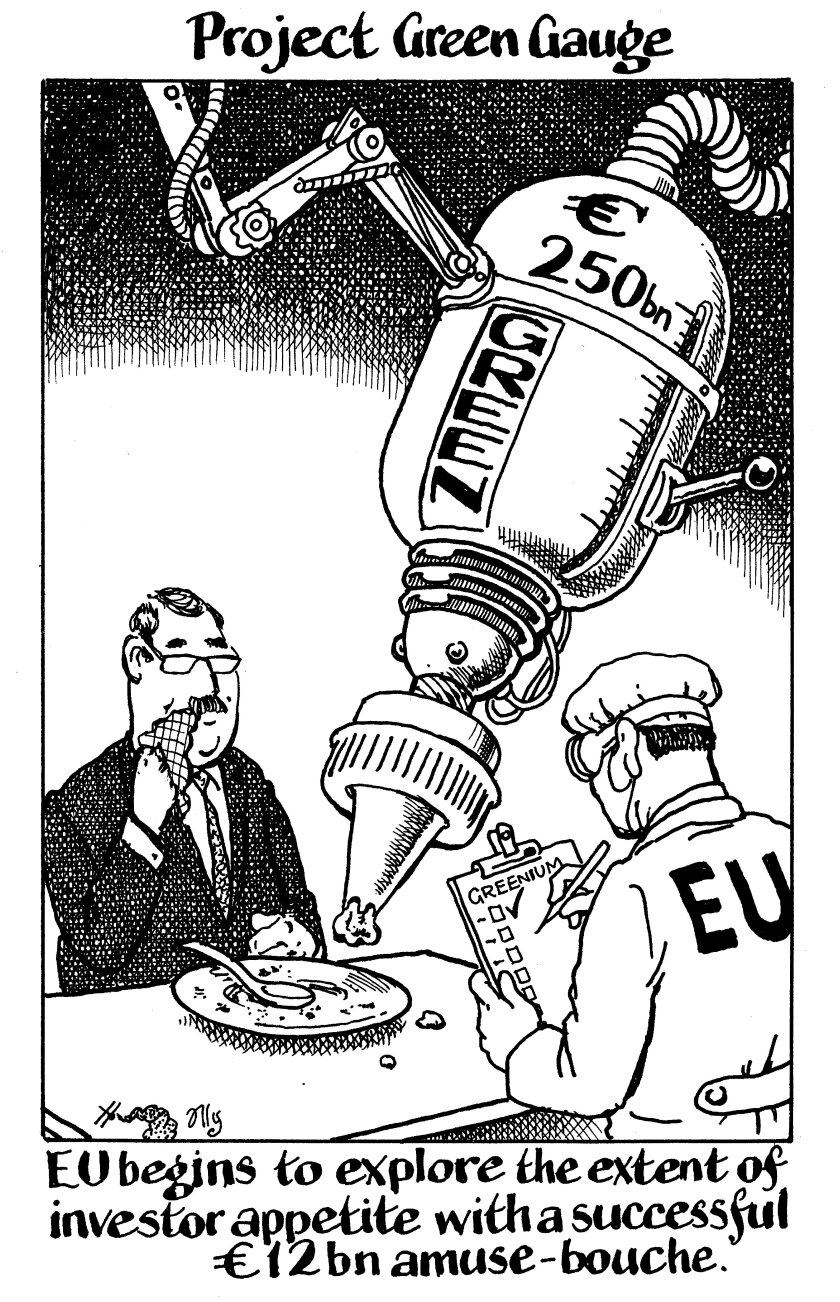There are growing concerns that the EU’s colossal green bond programme — which it launched this week with a record-breaking transaction — will put greeniums in the public sector bond market under pressure. A greenium is the discount awarded to issuers for issuing green bonds over conventional bonds as a result of greater demand than supply for these products.
The EU made an impressive statement as it printed €12bn for its debut green bond on Tuesday with an order book of more than €135bn, making it the biggest ever bond and order book for a green deal across any currency and asset class. It beat the previous record, set by the UK last month for its debut green Gilt, which was sized at £10bn (€11.8bn) with a book of more than £100bn (€117.8bn).
However, it was not quite the biggest ever order book received by the EU. The supranational attracted demand of more than €145bn with a 10 year transaction last October for its debut SURE deal — a world record that still stands in the capital markets.
Bank of America, Crédit Agricole, Deutsche Bank, Nomura and TD Securities led the sale of the EU’s debut green bond, due in February 2037. Danske, Intesa and Santander joined as co-leads.
The European Commission has said it will seek to raise 30% or up to €250bn of its Next Generation EU (NGEU) issuance in green format, making it the largest green bond issuer in the world. The huge supply over the coming years has fuelled concerns that this may lead to a compression in greeniums in the SSA bond market.
Greeniums under pressure?
“The sheer volume of supply from the EU may serve to eradicate some of that greenium in the sovereign/quasi-sovereign space,” said Kris Atkinson, portfolio manager at Fidelity International.
Atkinson added that greeniums were, however, not huge from frequent green issuers.
“With the work we have done, we see the greenium more evident in rare issuers and, in particular, rare sectors,” said Atkinson. “For frequent green issuers, particularly utilities, banks and quasi-sovereigns, there isn’t a huge greenium, maybe a couple of basis points here and there. Where we found greeniums really pronounced was from new issuers coming to the green bond market.
“The counter-argument to greeniums is whether there should be a differential between a green bond and a regular bond,” said Atkinson. “My argument is that there shouldn’t be. You take the same credit risk and the same yield. But there is also an argument that liquidity in green bonds is lower as they are typically buy-and-hold instruments from a core investor base. So, if liquidity is lower, there should be a liquidity premium.”
Isabelle Vic-Philippe, head of euro aggregate and lead portfolio manager at Amundi, said demand is still outweighing the supply of green bonds.
“For the time being there is too much demand and issuance is too low,” said Vic-Philippe. “But if green bonds become mainstream, the scarcity aspect of green bonds should disappear and greeniums should stabilise. At the moment, we are seeing greeniums of 4bp-5bp in the secondary market for the sovereign space, but this could decrease to 2bp.
“The sovereigns are the latecomers to the green bond market so that’s why their bonds have larger greeniums than other market segments,” added Vic-Philippe. “Also, green bonds reflect only a small part of their programme. This year, green bonds by European sovereigns will represent 3.5% of their total programme, far below what we see in the European corporate market of around 8.5%.”
“With the EU having issued its debut green bond and with more to come from the EU in the coming years, this could affect the supply-and-demand imbalance,” said Johann Plé, a portfolio manager at Axa Investment Managers. “But what we have been observing is that even though there has already been more than €300bn of green bond issuance this year, which is a lot more than in 2020, greeniums continue to materialise.
“Following the EU deal, we haven’t noticed any tightening of the greenium,” said Plé. “Over the long term, it could reduce sovereign greeniums, but at the moment it’s not enough to make an impact. There is strong demand for high quality assets that are green and there is just not enough. If we were to see some consolidation in the greenium, we would see it first on the EU’s curve.”
The EU priced its debut green bond flat to its own secondary curve, but taking into account the new issue premium it would pay for a conventional bond, the EU and its leads calculated a greenium of 2.5bp, in line with assessments by market participants away from the deal. The greenium grew later in the week, with the deal trading around 2bp tighter in the secondary market on Thursday.
Too soon to say
“Time will tell,” said Antoine Bouvet, senior rates strategist at ING. “It’s clear from the order book this week that there is still a supply-and-demand imbalance. That won’t be resolved by 12 yards. But €250bn? It’s hard to say.
“Greeniums grew strongly over the summer but have stopped since then, so it would appear that the squeeze part is over,” said Bouvet. “The summer greenium widening could have been caused by thin liquidity during the summer. Since then, we have had the UK and Spain as well as the EU [issuing green bonds].”
Mark Byrne, a syndicate banker at TD Securities, one of the leads on the EU’s debut green bond, agreed that a pressure on greeniums is “something we will only find out in time”.
“On a basic level, the greenium is a supply-and-demand issue,” said Byrne. “So as supply increases, the greenium could decrease. But from what we are seeing, demand is also increasing and well ahead of the increase in supply. Every fund manager has an ESG focus, so the buy side is only getting bigger.”
Sean Kidney, chief executive of the Climate Bonds Initiative, agreed that the investor base for green bonds is growing.
“There’s absolutely no question that there is enough demand for the EU and everyone else,” said Kidney. “I have spoken to investors who say they would start up a green bond fund, but there just aren’t enough assets to buy. Asset scarcity is the biggest limiting factor, so as we see more green bonds — from the EU, the UK, Italy. etc — more investors will be able to enter the market.”
“Bond markets are underpinned by the liquidity of higher grade assets, so the EU will make a huge difference, not just to the green market, but to the euro market generally, where a lack of high quality debt is a problem for investors,” said Kidney. “The volume and liquidity should be a magnet for other borrowers.”
Green benchmark?
The EU’s arrival in the green bond market has also sparked debate over whether it will become the main benchmark for European green bonds.
“The fact that the EU will issue large outstanding amounts and have a full curve will be good for the market to use this as a reference,” said Vic-Philippe “The EU has the opportunity to become the reference curve for the green market segment.”
“It’s clear that with the size of their programme, they will be a unique issuer of green bonds, in that they will be able to have a green curve very quickly,” said Benjamin Moulle, head of SSA syndicate at Crédit Agricole, one of the leads on the EU’s debut green bond. “Whether the EU will be the reference green issuer, that will be for the market to decide. The EU’s green bond programme will be to the benefit to the whole green bond market.”
Peta Wehlert, head of capital markets at KfW, which this week sold the biggest ever green bond in dollars, said it is “useful to have the EU’s green curve to reference”.
“We can also look at the green Bund curve with the twin bond structure,” said Wehlert. “The EU coming to the green bond market is a good thing, and we have a positive attitude towards that.”
Additional reporting by Lewis McLellan.





